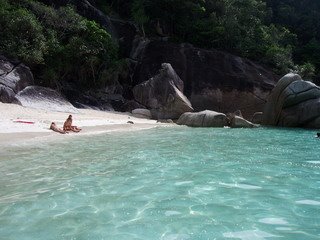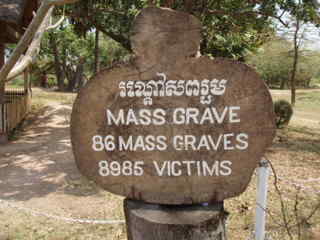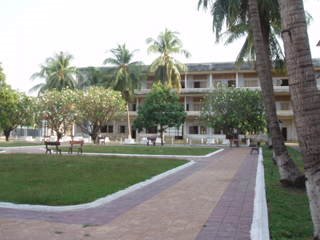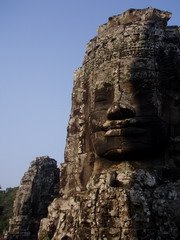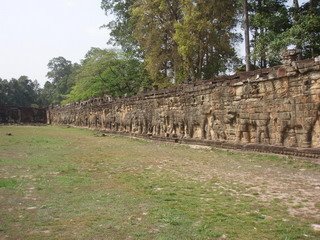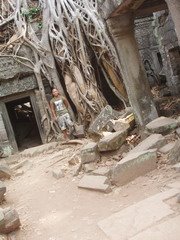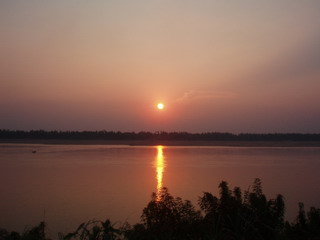The bus journey from the Cambodian border to Phnom Penh, the capital of Cambodia, was the roughest I have experienced yet. The road to Phnom Penh was uneven and littered with potholes. When we stopped finally stopped in Phnom Penh, my teeth were chattering, and my brain was scrambled.
I visited Phnom Penh for one day, and two nights. The first night was quiet, as most first nights are when visiting a new town or city. The first day started with a solemn moto ride to the Killing Fields. Cambodia's history is horrifying. During the seventies, Cambodia was run the Khmer Rouge, probably the most ruthless government in 20th century. At first, the Khmer Rouge fought for a stronger, cooperative Cambodia. Many Cambodians were supported the early ideology of the early Khmer Rouge party, and fought with the Khmer Rouge against the capitalist supported government. In 1975, the Khmer Rouge army captured Phnom Penh. Now in power, the Khmer Rouge led by Pol Pot started to revolutionize Cambodia into an extreme form communism. A revolution that led to the destruction of Buddist temples (including Angkor Wat), the closing of banks, schools, and factories, the oppression of free speech, and the genocide of over 2 million Cambodians. The Killing Fields was an extermination center during the ruthless Khmer Rouge rule. Children were swung head first into trees. Women and men were buried without their heads. In total, over 9000 people were buried at the field I visited. Many of the graves were excavated during the eighties. Signs mark where mass graves were once laid.
In the afternoon, I visited a local prison run by the Khmer Rouge in the seventies. Named S-21, the prison was once a large high school in the suburbs of Phnom Penh. Khmer Rouge interviewed, imprisoned, tortured and killed thousands of Cambodians at S-21. Electricity, water, and tools were used regularly to torture prisoners at S-21. Prisoners that didn’t die at S-21 were transported to the killing fields for final extermination. When the Vietnamese government overthrew the Khmer Rouge, S-21 was left untouched, a callous reminder of the form of mankind. I remember seeing dried blood on some of walls, and empty beds where I was certain many prisoners of S-21 perished. The Khmer Rouge known for being meticulous. Inside S-21 are individual photos of each prisoner, and pictures of how some died. I spent over 3 hours at S-21. I was deeply disturbed when I left.
The following day, I got on a bus to Sianoukville. Sianoukville, named after one of Cambodia’s kings, is a renowned for its scenic beach. In Sianoukville, I visited the surrounding islands and snorkeled during the day. At night, I went out with friends I met along the way. By now, I had befriended a large group of international travelers. Sweden was heavily represented, followed by the United States, and New Zealand in my new group of instant friends. One of my fondest memories of Siaoukville is being tackled into the sea in the middle of the night. When I said a final goodbye to those that I befriended in Siaoukville, I didn’t realize I would meet many of them again in Laos and Malaysia again.
After Siaoukville, I had to visit to Phnom Penh again to pickup a visa for Laos. It is then I concluded that Cambodia is a difficult country to travel through. Most of the highways are not paved, and are not serviced by coaches or buses regularly. I picked up my visa in Phnom Penh, and caught a bus the day after to Siam Riep to get a glimpse of Angkor Wat. I’m not a history buff; my recollection of how Angkor Wat is lost. Angkor Wat was a large city created before 10th century. Now in ruins, Angkor Wat represents the perhaps best and largest display of Buddhist temples of the time period. My day at Angkor Wat started at 5am in the morning to catch sunrise. During the day, he took me to various temples near and around Angkor Wat. The most impressive temple I saw was called Byron. Byron is memorable for its height, large size, and flora of granite faces of Buddha that line the outside of the temple. For you movie buffs, Angkor Wat was also featured in the first Tomb Raider movie. Perhaps, this is where Angelica Jolie first met Maddux, her adopted Cambodian son.
With only a month to travel between Laos and Cambodia, I could only spend one day at Siam Riep, and had to leave for Southern Laos the next day. The trip to Southern Laos took me two days in total. Though Siam Riep is located in Northern Cambodia, I could not travel directly to Laos from there. I followed a route shaped like a large horseshoe to Laos. First, I had to travel south to Kampong Cham, and catch a taxi north to Kratie. In Kratie, I would spend a night, then travel northward to the Cambodian Lao border by speed boat, and reach the land of 1000 islands in Laos by the end of the second day.
On the way to Laos, I met a young couple from Denmark. Kerry and Anders were on their way to Laos as well. We had fun negotiating the taxi to Kratie from Kampong Cham. Mostly arguing, and fighting for the best price. The ride in the taxi was epic. The taxi was a mid-80s Toyota Camry normally built to accommodate a small family. When we were negotiating the price, the driver mentioned to us that we would leave once the taxi was full. He needed seven people. When we piled into taxi, there were four of us in the back seat, two passengers in the passenger seat, and two people in the driver’s seat. The driver sat on one of the passenger’s lap. As the driver negotiated the road, we rode in back of the taxi listening to covers of Black Eyed Peas’ My Humps, and House of Pain’s Jump Around in Cambodian.
The next day, we arranged another shared taxi to Strung Trang, and booked a fast boat to Laos. In the taxi, Kerry mentioned to me that one of the passengers in the taxi was carrying a gun. I was worried that we would be hijacked on the way to the border. Thankfully, nothing happened.
Fast boat travel in Asia is the loudest, and perhaps the most dangerous way to travel on water. Fast boats travel at speeds of 60km/h on shallow water. The boats are powered by old 4 cylinder engines and have little protection for the passengers in the event of an accident. The hour boat ride to border was fast, loud and a bit scary, just as I expected. Before sunset, we were finally rewarded for our patience. We finally reached the land of 1000 islands in Southern Laos, and settled into bungalows on the foot of the Mekong River.


